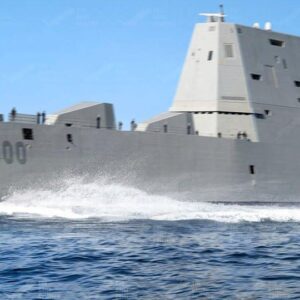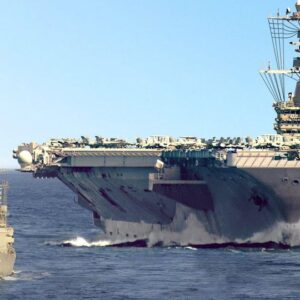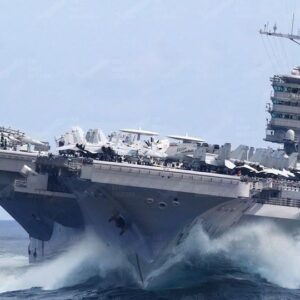The German H-Class battleships were a series of proposed World War II-era battleships, representing the pinnacle of Nazi Germany’s naval ambition with unprecedented size and firepower.

Designed as the successors to the Bismarck-class, these ships were planned to significantly outclass all existing naval vessels in terms of armament, armor, and displacement.
Though never constructed, the H-Class remains a subject of intense interest, symbolizing the ultimate expression of pre-World War II battleship design and the dramatic shift in naval strategy during the war.
Background
The Treaty of Versailles limited the size and capability of the German navy to prevent any future threat to Britain and other countries.
Germany was allowed only small battleships, no submarines, and a very limited navy.
This treaty was a source of humiliation and resentment in Germany, fueling a desire to reassert its naval power and prestige.
With the Nazi regime’s ascent, there was a clear ideological and strategic shift toward expanding Germany’s military might, including its naval forces.
Hitler envisioned a powerful fleet that could challenge the British Royal Navy, historically the world’s most dominant naval force.
This vision was part of a larger strategy to ensure German dominance in Europe and project its power globally.
In 1935, the Anglo-German Naval Agreement allowed Germany to expand its navy to a certain extent, legally bypassing some of the Versailles restrictions.
This agreement permitted Germany to build a navy up to 35% of the size of the British Royal Navy, including battleships.
This development was a pivotal moment, as it essentially sanctioned the expansion of German naval power and paved the way for the conceptualization and planning of more powerful ships, including the H-Class battleships.
 An illustration of the proposed ‘H-Class’.
An illustration of the proposed ‘H-Class’.
Against this backdrop of rearmament and aspiration, the H-Class battleships were conceived.
These ships were to be the epitome of naval engineering and power, far surpassing the size and armament of Germany’s existing battleships.
The idea was to build a fleet that could directly challenge the British and French navies, ensuring German dominance in the North Atlantic and beyond.
The H-Class battleships were a bold statement of intent. They reflected not just a desire for parity with Britain’s Royal Navy but an ambition to surpass it.
The Kriegsmarine’s leadership, under Admiral Erich Raeder, was instrumental in advocating for these powerful ships, believing that a strong battleship fleet was essential for Germany to achieve its strategic goals.
As these battleships were being planned, there was also an evolution in naval doctrine, reflecting new technologies and strategies.
Battleships were traditionally seen as the dominion of sea power, but emerging technologies like aircraft carriers and submarines began to challenge this notion.
Despite these shifts, the H-Class battleships represented a commitment to the idea of decisive battleship encounters, a concept that was becoming increasingly obsolete with the advent of new naval warfare strategies.
Design Of The H-Class
The design and specifications of the German H-Class battleships were ambitious, intended to establish Nazi Germany’s naval supremacy with ships that were larger, more powerful, and better armored than any of their contemporaries.
As successors to the Bismarck-class battleships, the H-Class represented the pinnacle of interwar naval engineering, with several iterations from H-39 to H-44, each more formidable than the last.
The initial H-39 design set the tone for what was to come, calling for a ship displacing approximately 56,000 tons, armed with eight 16-inch (406 mm) guns capable of long-range engagement.
These ships were to be heavily armored, with extensive steel plating covering critical areas, and fast enough to outmaneuver opponents, reflecting the balance of speed, firepower, and protection that characterized battleship design of the era.
 One of the 40.6 cm guns intended for an early H-Class battleship was used in the Lindemann Batterie on the Atlantic Wall. The barrel was around 20 metres (66 ft) long.
One of the 40.6 cm guns intended for an early H-Class battleship was used in the Lindemann Batterie on the Atlantic Wall. The barrel was around 20 metres (66 ft) long.
Subsequent designs escalated these specifications dramatically. The H-40 and H-41 versions contemplated increases in displacement and firepower, with H-41 nearing 68,000 tons and considering larger 17-inch guns.
The apex of this design evolution was the H-44, a proposed leviathan with a displacement of over 140,000 tons and armed with eight 20-inch (508 mm) guns, the largest ever planned for a battleship.
At over 330 meters in length, it would have been a behemoth by any standard.
These battleships were to incorporate the latest technology in propulsion, armament, and armor. Advanced steam turbines and boilers were designed to give these giants the speed to compete with smaller ships, while extensive anti-aircraft defenses and aircraft facilities were included to mitigate the growing threat of air power.
However, the size and complexity of these ships presented significant challenges, from finding docks large enough to accommodate them to managing the immense logistical and material demands of their construction.
The Impact Of The War
The impact of World War II had profound implications on the fate of the German H-Class battleships, altering the course of their development and ultimately leading to the cancellation of the program.
The onset of the war and the rapidly changing nature of naval warfare, along with Germany’s shifting strategic priorities, contributed to the demise of these ambitious vessels.
As World War II progressed, the realities of prolonged and multifaceted warfare began to set in. Germany found itself engaged on multiple fronts, requiring a diverse array of military resources.
The immediate needs of the war—such as producing more submarines, aircraft, and smaller ships—became paramount.
These assets were deemed more critical to the immediate war effort, particularly in the Battle of the Atlantic, where U-boats were seen as a key tool in disrupting Allied supply lines.
The construction of the H-Class battleships required an immense allocation of resources, including steel, labor, and industrial capacity.
As the war intensified, these resources became increasingly scarce and were redirected towards more immediate wartime needs.
The sheer scale of the H-Class design meant that their construction would be a long and resource-intensive process, a luxury that could not be afforded in the face of urgent wartime demands.
The war also saw significant evolution in military technology and tactics, particularly in naval warfare.
The effectiveness and dominance of battleships were increasingly challenged by newer forms of naval power, such as airpower and submarines.
Aircraft carriers began to prove their worth as the central players in naval engagements, capable of projecting power far beyond the range of any battleship’s guns.
Meanwhile, submarines offered a stealthy and effective means of disrupting enemy supply lines and naval operations.
In this changing landscape, the concept of giant battleships began to seem outdated and less relevant to the realities of modern warfare.
The rise of airpower dramatically changed naval engagements. Battleships, with their large profiles and relatively slow speeds, became vulnerable to attacks from the air.
The war demonstrated the destructive potential of aircraft against surface ships, as seen in the sinking of major battleships like the Tirpitz.
This vulnerability further diminished the strategic value of investing in more massive and expensive battleships.
 The battleship Tirpitz was was destroyed during an RAF raid.
The battleship Tirpitz was was destroyed during an RAF raid.
One Of Germany’s ‘What-Ifs’
The legacy of the German H-Class battleships, though they were never completed or saw combat, continues to captivate historians, military strategists, and naval enthusiasts.
The “what-ifs” surrounding these ships are a source of endless speculation, touching on how they might have altered naval battles, the course of World War II, and naval architecture.
Had the H-Class battleships been completed, they would have represented the apex of battleship design and potentially set new standards for naval engagements.
Historians and naval enthusiasts often speculate on scenarios where these ships could have engaged the fleets of the Allies. With their superior size, armament, and armor, they might have posed a formidable challenge to any naval force of the time.
However, these speculations often take into account the vulnerabilities and limitations of battleships that were becoming apparent during the war, such as susceptibility to air strikes and torpedoes.
The H-Class battleships are often regarded as symbols of the technological ambition and military might that Nazi Germany sought to project. The sheer scale and capabilities of these ships were meant to intimidate opponents and assert dominance at sea.
Their design pushed the boundaries of naval engineering and has since been studied as a pinnacle of battleship concept.
Even in their absence, they influenced naval design and strategy, representing the ultimate potential of battleship development.
The H-Class battleships’ designs have provided valuable lessons in naval architecture and the limitations of battleship-centric strategies.
They are a testament to the era’s engineering capabilities and also to the overreaching ambitions that can drive military planning.
Naval architects and military historians study these designs to understand the evolution of battleship technology and the transition to new forms of naval power.
The H-Class serves as a cautionary tale about the risks of focusing on grandeur and power at the expense of adaptability and strategic foresight.
“What-if” scenarios regarding the H-Class often delve into how they might have changed the dynamics of World War II had they been operational.
Questions arise about their potential impact on major naval battles, their vulnerability to the evolving tactics of the war, and how they might have influenced the strategies of both Axis and Allied powers.
These discussions often extend into the broader implications for the war’s outcome and post-war naval strategy, offering a fascinating glimpse into an alternate history that might have been.
The mystique of the H-Class battleships extends beyond their military implications.
They have become a part of popular culture and naval lore, appearing in literature, documentaries, and discussions as symbols of ultimate power and human ambition.
The legacy of the H-Class battleships endures, not as tangible artifacts of war, but as powerful symbols of what might have been, inviting reflection on the intersections of technology, strategy, and historical trajectory.





